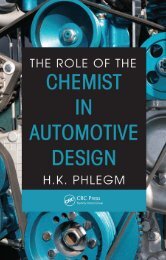Lightweight Electric/Hybrid Vehicle Design
Lightweight Electric/Hybrid Vehicle Design
Lightweight Electric/Hybrid Vehicle Design
You also want an ePaper? Increase the reach of your titles
YUMPU automatically turns print PDFs into web optimized ePapers that Google loves.
Current EV design approaches 17<br />
has introduced a new design to help overcome some of the problems. The so-called Gemini series<br />
consists of an armature with a face commutator at both ends of the armature. This permits two<br />
independent windings which may be connected in series or parallel. Improvements in the torque<br />
speed curve are seen in Fig. 1.14, while Fig. 1.15 shows a recently developed controller. While<br />
existing controllers have single quadrant choppers with contactors for reversing and braking, and<br />
field control is effected by a separate chopper unit, Polaron feel such a design gives limited overall<br />
performance and is better replaced by the arrangement shown. Brushed DC motors have a role in<br />
applications below 45 kW but, if power rises above this figure, mechanical considerations such as<br />
the removal of heat from the rotor become more important. There are also factors to take into<br />
account in terms of efficiency when partially loaded. In many of these respects, the use of brushless<br />
DC motors could provide a better alternative. These have a number of features acting in their<br />
favour, including high efficiency in the cruise mode and a readily adjustable field, plus the practical<br />
benefits of a more easily made rotor.<br />
1.3.3 BRUSHLESS DC MOTOR<br />
The term ‘brushless DC motor’, however, is a misnomer. More accurately it should be described<br />
as an AC synchronous motor with rotor position feedback providing the characteristics of a DC<br />
shunt motor when looking at the DC bus. It is mechanically different from the brushed DC motor<br />
in that there is no commutator and the rotor is made up of laminations with a series of discrete<br />
permanent magnets inserted into the periphery. In this type of machine, the field system is provided<br />
by the combined effects of the permanent magnets and armature reaction from vector control.<br />
Similar in principle to the synchronous motor, the rotor of this machine is fitted with permanent<br />
magnets which lock on to a rotating magnetic field produced by the stator. The rotating field has<br />
to be generated by an alternating current and in order to vary the speed, the frequency of the<br />
supply must be changed. This means that more complex controllers based on inverter technology<br />
have to be used.<br />
Induction motors are used by many US battery-electric cars. The rotors are cooled with internal<br />
oil sprays which also lubricate the speed reducer. Operation at 12 000 rpm is common to minimize<br />
the torque and some designs operate under vacuum to reduce the noise. The one good point is that<br />
these motors are reasonably efficient under average cruise conditions (8000 rpm, 1/3 FLT). Polaron’s<br />
view is their use will be short lived. Induction motors always have lagging power factors which<br />
cause significant switching losses in the inverter, and vector control is complex.<br />
Fig. 1.15 Integral 4-quadrant chopper.<br />
1<br />
2<br />
If<br />
Ef<br />
3<br />
4<br />
Ea<br />
Ia<br />
A 1<br />
FORWARD BRAKING FORWARD MOTORING<br />
2<br />
Ia<br />
If<br />
Ef<br />
If<br />
Ef<br />
Ea<br />
4<br />
3<br />
1<br />
2<br />
Ia<br />
If<br />
Ef<br />
If<br />
Ef<br />
Ea<br />
REVERSE BRAKING REVERSE MOTORING<br />
Ia Ea Ia Ea<br />
4<br />
3







